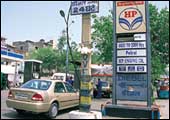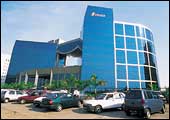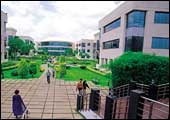|
Management is a four-letter word in Scott
Adams' Dilbert comics. The managers are, invariably, dumb and, invariably,
mean-spirited. Humorous that may be; fair, it isn't. The M factor
(M for management), experts now admit, could explain some of the gap
between the actual price of a company's scrip, and the price dictated
by its fundamentals. That's the power of M. The 16 companies that
made it to the final round of the first BT-A.T. Kearney India's Best
Managed Company study stand testimony to this. One, Hindalco,
has offset the aluminium business cycle to which it is vulnerable
by diversifying into copper, which has a complementary cycle. Another,
Asian Paints, has ridden to domestic success on the back of its marketing
and it strategy and has now acquired global manufacturing facilities.
And still another, Reliance, is successfully juggling a complex portfolio
of businesses. Adams, it would appear, is wrong. M does matter. Unconvinced?
Read on.
ASIAN PAINTS /ASHWIN DANI/VICE CHAIRMAN
A Global Brushstroke
 |
| Brand success: In many ways, Asian as
a consumer goods company |
When a company has manufacturing facilities
in 13 countries and a presence in 24, it can claim to be truly global.
Courtesy, the recent acquisitions of Berger International, Singapore,
and SCIB Chemical, Egypt, Asian Paints has just that. None of this
is a chance occurrence. In the early 1990s, Asian Paints decided
that the logical next-step for it was to go global; since then,
it has worked towards that goal.
On the strength of its unique-for-a-paints-company advertising,
Asian Paints has built one of India's strongest consumer brands
despite not being either a fast moving consumer goods (FMCG) or
consumer durables company. And it has amongst the most wired supply
chains in India Inc, something that translates into a definite advantage
in terms of distribution and cost control.
Vice Chairman and Managing Director, Ashwin Dani, believes this
is responsible for the consistent improvement in the company's operating
margins, up to 17.68 per cent today from 14.81 per cent five years
ago. With more investments in it lined up, Asian Paints is making
sure it doesn't lose the advantage.
 BRITANNIA
INDUSTRIES/SUNIL ALAGH/MANAGING DIRECTOR BRITANNIA
INDUSTRIES/SUNIL ALAGH/MANAGING DIRECTOR
Twice-baked, Twice-born
|
|
BRITANNIA INDUSTRIES
Sunil Alagh |
Fine, the company has recently been
in the news (this magazine, even) for all the wrong reasons, but
Britannia remains one of India's most enduring food brands. The
gloom in the FMCG domain has left biscuits largely untouched and
the company, with a 60 per cent share of the market, and a strong
presence in the lower-end, looks set to achieve its target of making
every third Indian a Britannia consumer. The company's decision
to divest its growing dairy business to a joint venture with New
Zealand's Fonterra Co-operative Group may slow its growth rate some
but, as another school of thought goes, it could help the management
focus exclusively on biscuits. It's all they've got, but it should
do.
CADBURY INDIA/BHARAT PURI/MD
A Private Affair
|
|
|
CADBURY INDIA
Bharat Puri
|
The company that made it alright for
adults to crave chocolates-it also remade its fortunes in the process-will
certainly not be part of the sample for the next edition of India's
Best Managed Company: following a buyback by its parent, the UK-based
Cadbury Schweppes, the company was delisted from the bourses in
2002. Like Britannia, Cadbury has an objective defined in terms
of consumers, "a Cadbury in every pocket." And like FMCG
behemoth Hindustan Lever Limited-it made it through the numerical
filters of the survey but chose to take the fifth- Cadbury has a
power-brand strategy. With an aggressive foray into the low-end
with Chocki, a squeeze-out chocolate GOO aimed at children, and
launches at the high-end of the market, Cadbury seems on its way.
The fact that chocolates remained immune to the slowdown in the
overall fmcg market helped, not that the company needed it.
DR REDDY'S LABORATORIES/DR ANJI
REDDY/CHAIRMAN
The Innovator's Dilemma
|
|
|
DR. REDDY'S LABORATORIES Anji Reddy
|
Dr Reddy's wants to be a discovery-driven
global pharma company. That's a stretch target that could take time
and money. To fund the discovery business, the company is focussing
on the lucrative generics market in the US; with several blockbuster
drugs going off patent by 2005, this market could be, by some estimates,
as large as $10 billion (Rs 47,000 crore). The balance between the
promise of exponential growth (thanks to new discoveries) and a
steady cash flow (arising from generics) is what makes the company
unique. More in our feature on Page 92.
 |
| Gurgaon: India's urban renewal over the
past decade may have benefited Gujarat Ambuja, but the company
has left nothing to chance |
GUJARAT AMBUJA CEMENTS/NAROTTAM
SEKHSARIA/MANAGING DIRECTOR
Yes, Cement's Sexy
|
|
|
GUJARAT AMBUJA CEMENTS Narottam Sekhsaria
|
It's easy to say this: Gujarat Ambuja
is the best cement company in India, period. It's tough being a
successful cement company in India: retail prices are largely outside
the control of individual companies. Still, GACI has grown by focussing
on volumes and cost control. It has also made a strategic investment
in cement major acc and as Anil Singhvi, Executive Director of the
company, says, "Competitors can work together and Gujarat Ambuja
and acc demonstrate that." The cyclical nature of cement prices
remains a matter of concern but the housing boom and the government's
emphasis on infrastructure are certain to result in an increase
in demand. That could result in improved profitability for all cement
companies in the country. As it often happens in such cases, the
company that is the least-cost manufacturer, and the most efficient
in terms of logistics- and distribution-management stands to gain
the most. Gujarat Ambuja is that company.
|
|
|
HINDALCO INDUSTRIES K.M. Birla
|
HINDALCO INDUSTRIES/KUMAR MANGALAM
BIRLA/CHAIRMAN
Aluminium Standard
Purely on the strength of its strategy,
Hindalco deserves to be in this choice set. Not too long ago, the
Aditya Birla Group company was just another aluminium producer.
Today, in the wake of the acquisition of Indal, it is India's largest.
"Once the government firms up its plans for Nalco, we will
bid for that too," says full-time director A.K. Agarwala. The
company has also sought to hedge its vulnerability to global aluminium
prices by diversifying into copper-the cycles of the two businesses
are diagonally different-by acquiring the copper business of stablemate
Indo Gulf. To insulate itself better, Hindalco has launched semi-fabricated
and value-added aluminium products, acquired copper mines in Australia,
and initiated efforts to reduce its cost by around $50 (Rs 2,400)
a ton. "The cost-cutting drive (initiated at the end of FY
02), will give results after 18-24 months," says Anant Katare,
an analyst at Khandwala Securities. Acquisitions, capacity expansions,
diversifications, and a strategic move up the value chain, surely,
there's little else a company can do?
HDFC BANK/ADITYA PURI/MANAGING DIRECTOR
Systemic Success
Among the first new private banks
in India, HDFC bank is a study in systemic efficiency. Its technology
(fairly advanced stuff, if you must know) is scalable, and its costs,
among the lowest in the business. Constrained by its parent's focus
on mortgages from entering the business, HDFC Bank has augmented
its banking operations by cross-selling products such as depository
and bill-payment services, mutual funds, and investment advice.
And it boasts among the best risk management systems in the industry.
For instance, on March 31, 2002, its portfolio of funded exposure
(including advances and corporate debt) was highly diversified with
each of 28 industries accounting for 1 per cent or more. That could
explain why its non-performing assets, as a proportion of total
assets is well below 1 per cent. Read all about HDFC Bank on Page
96.
 |
| Retail Play: Even as its disinvestment
continues to be debated, HPCL has increased its retail-focus |
HPCL/M.B. LAL/CHAIRMAN AND MD
The most efficient of them all
Even as the blow-hot-blow-cold disinvestment
saga of Hindustan Petroleum Corporation Limited (HPCL) continues,
the company continues to remain the most efficient public sector
oil company. To deal with the coming competition in petro-marketing,
HPCL has acquired some of its dealer-owned outlets and done them
up, convenience stores, ATMs, the works and more. "We are entering
allied businesses," says M.B. Lal, Chairman and Managing Director,
HPCL. "One is an alliance with car rental agency Hertz."
Apart from the emphasis on retail, the company is focussing on
reducing cost and increasing efficiency, the two universal mantras
of well-managed companies anywhere in the world. Its presence in
this list is reflection enough of its ability to do that.
 |
| Aggressive Universal Bank: And yesterday,
it was a development finance institution |
ICICI BANK/K.V. KAMATH/CEO
It's a universal bank!
Yesterday's development finance institution
is today the country's second largest bank and its first universal
bank. It boasts the largest ATM network in the country, is the #1
car finance company and the #2 mortgages one and its subsidiaries
in the asset management and insurance business are the #1 private
sector players in both. Much of this stems from its aggressive retail
play even when ICICI and ICICI Bank were disparate entities-the
aggressiveness was a ploy to reduce the risk of ICICI's traditional
portfolio. The NPAs inherited from ICICI remain an area of concern
but the merged entity's diversified asset base and its rapidly expanding
retail base has reduced this risk. And the new Securitisation Bill
could help it recover old loans smoothly.
 |
| Media-and investor-darling: Forget its
consistent performance, Infosys has a squeaky clean image, rare
in India Inc. |
INFOSYS/NANDAN NILEKANI/CEO
Transparency Troubadour
Can any listing of India's best managed
ever be complete without Infosys? The company has won innumerable
awards (including being named BT-Hewitt Best Employer in India twice),
maintained its position in the 10 most valuable companies by market
capitalisation (this, despite the recent meltdown), and is renowned
for its transparency and good management practices. We could go
on and on and say a lot more but suggest you turn to Page 106 instead.
MOSER BAER/DEEPAK PURI/CEO
They do it with Optics
The logical next step for floppy disk
manufacturers was to have diversified into optical media such as
compact discs (CDs) and digital video discs (DVDs). Few Indian companies
made it in floppies, and only one has managed the transition.
Actually, that sentence is a trifle unfair to Moser Baer, for
the company hasn't just made the shift but is, today, a player of
note in the global market for optical media-it has a marketshare
of around 11 per cent. It has achieved this position on the strength
of its global-scale facilities and efficient operations.
Moser Baer's recent decision to up DVD capacities will help it
cut costs further. Already, its products are among the least-priced
on offer, one reason why it is a regular target for investigations
on the charge of dumping. The European Union recently cleared the
company of dumping charges but has imposed a countervailing duty
of 7.3 per cent on its products. Even this won't hurt Moser Baer
and its products will remain around 10 per cent cheaper than the
competition's. Bravo! (turn to Page 102).
|
|
|
RELIANCE INDUSTRIES
Mukesh & Anil Ambani
|
RELIANCE INDUSTRIES/MUKESH AMBANI/CHAIRMAN
Managing Complexity
Reliance is the largest private sector
company in India and the only Indian private sector company to figure
in Fortune magazine's list of the world's 500 largest companies,
but size isn't the reason the company is here. Nor is it the company's
performance in terms of topline and market value growth, the axis
of the value creation matrix that formed the basis of the BT-A.T.
Kearney study-although, it must be mentioned that Reliance's performance
so skewed the matrix that almost all other companies in the process
industry suffered by comparison.
 |
| Ambitious Diversification: Since 1996,
RIL has become a refining and telecommunications major |
The reason for Reliance's presence among India's Best Managed Company
is attributable, more than anything else, to the company's ability
to effectively manage large-scale projects-yes, we all know the
first launch of Reliance Infocomm didn't go too well but everyone
would have been surprised if it did-in fairly diverse areas.
Today, the company is a big player in refining, petrochemicals
and telecommunications; its exploration business has had some big
wins, like the 10.45 trillion cubic metres (reserves) of gas it
struck in the Krishna-Godavari basin; it is poised to enter petro-products
retailing; and Reliance Lifesciences is among the few companies
in the world actively engaged in stem cell research. Being big and
successful over a period of time is not as simple as it looks on
paper but Reliance Industries has managed just that. For details
on how exactly it achieved this, turn to Page 44.
|
|
|
SATYAM COMPUTER
Ramalinga Raju
|
SATYAM COMPUTER/RAMALINGA RAJU/CHAIRMAN
The Third Company
The appreciating rupee and falling
margins are a cause of concern for Satyam computer as they are for
other Indian it services companies. Still, Satyam is doing everything
in its powers to ensure that its growth -it was the fastest growing
company in its genre in India till recently-isn't hit. The company
is expanding into new regions, Europe and West and South Asia (it
is already present in 43 countries); is already the largest sap
specialist in India (this business alone has 50 global customers);
has recently diversified into the go-go BPO space through a new
venture, Nipuna services; and is considering exiting altogether
from its just-turned-profitable internet access business, Sify (it
has gradually reduced its stake in this business). It'll be tough
for the company-operating profit declined by 19 per cent in 2002-03;
net profit by 32 per cent-but that's a problem the entire software
services industry in India has to live with.
 |
| Comeback bike: The completely locally-developed
Victor helped the company ride back to wellness |
TVS MOTOR/VENU SRINIVASAN/CHAIRMAN
Solo Victor
|
|
|
TVS MOTORS
Venu Srinivasan
|
Normally, when Indian companies break
up with their joint venture partners they go through a regulation
period of suffering. Not TVS. Since breaking up with Suzuki, it
has launched its indigenously developed four-stroke motorcycle Victor
and has increased its sales by close to 3 lakh units between 2001-02
and 2002-03. "We are developing new products for the domestic
and international market. We have spent around Rs 80 crore on development
during the year 2002-03. It will be higher this year," says
C.P. Raman, President, TVS Motor. Add to that, its superior manufacturing
systems-it is the only auto company and the third Indian company
to win the Deming Medal for quality-and it is easy to see why TVS
Motor is a shoo-in for a listing of this nature.
 |
| Tapping the domestic market: Sun's marketing
focus has helped it grow its share |
SUN PHARMACEUTICAL INDUSTRIES/DILIP
S. SHANGHVI/CHAIRMAN AND MD
Home-grown success
|
|
|
SUN PHARMACEUTICAL INDUSTRIES
Dilip S. Shanghvi
|
Sun pharmaceutical has become one
of India's fastest growing pharma companies on the strength of its
focus on new drug delivery systems and its emphasis on marketing.
Six of its brands are among the most prescribed in the country,
and the company has consistently grown its marketshare. Like its
peers, Sun has a presence in the US market, but through a subsidiary,
Carraco, in which it holds just under a 50 per cent stake. Sun supplies
speciality bulk drugs to Carraco, which has already received approvals
for six ANDAs (Abbreviated New Drug Applications)-the company will
file six more ANDAs before the year is out. "We are stepping
up our research efforts. In two year's, our R&D spend will go
up to 6 per cent. And we have started filing applications from India
as well," says Dilip Shanghvi, Sun's Chairman and MD. Now you
know.
WIPRO/AZIM PREMJI/CHAIRMAN
Software Raider
In the mid-1990s Wipro was, let's
face it, a seemingly confused company with low margins. Its profitability
may have taken a hit in the last quarter but today, the company
presents a different picture. The company's recently eroded margins
are still healthy; it boasts a positive economic value added (EVA);
it has built managerial bandwidth; and it has put the cash on its
balance sheet to good effect, making a slew of strategic acquisitions.
The Spectramind deal that facilitated the company's entry into the
booming business process outsourcing (BPO) market was initially
panned by analysts; now, there's a growing realisation that Wipro
didn't come off too badly from the acquisition. And the company
probably boasts the best business processes in the industry.
Purely in terms of the distance it has had to cover, Wipro has
done more than any other company in its industry in India. The company
has had its failures-such as its internet service provider business-and
it still retains a niche presence in soaps, toiletries and lighting
but these businesses are profitable and do not really take away
anything from its mainstay software business. And the hardware arm
has actually helped the company position itself as a system integrator
of some note.
As for the pressure on profitability, most analysts expect the
company to come through largely unscathed. "Wipro will be able
to withstand the current slowdown with ease," says Gurunath
Mudlapur of Khandwala Securities. For more, turn to Page 106.
|

